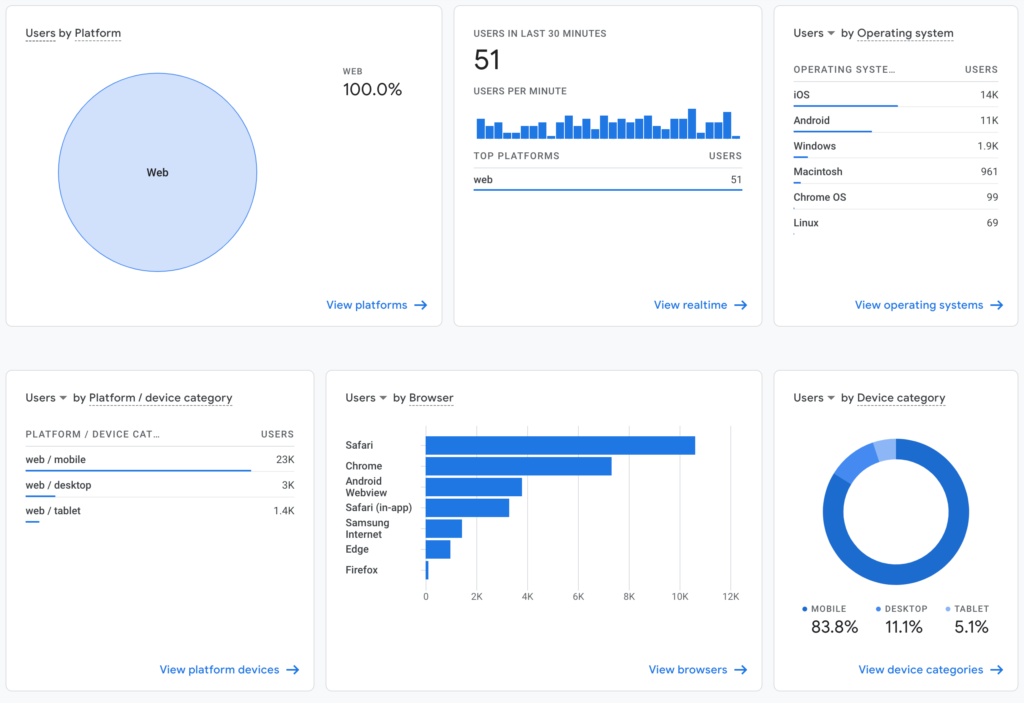Prepare For the New World of Google Analytics 4
Come 1 July 2023, Google Analytics as you know it will no longer process your data and you will need to transition to Google’s next generation of analytics tools on Google Analytics 4 from Universal Analytics for “App + Web“, as we know it. Universal Analytics 360 properties will, however, allow for a further three months of new data processing, given its fairly recent introduction; this ends 1st October, 2023.
We recommend digital marketers start working with this latest ad platform, primarily because being ready for the changeover will put you ahead of your competitors. who may only transition closer to the time. By then, you will be used to your new Google analytics system and be benefiting from it.
Making the transition means you benefit from advantages over Universal Analytics. such as:
- Privacy-focus
- Future-proofing
- More intelligent machine learning offering greater insights into customer journeys “across platforms and devices”
- Last, but not least: “Enhanced, seamless integrations with Google’s advertising platforms…” This promises to improve campaign performance optimisation and marketing ROI
Why The Google Analytics 4 Upgrade?
As we might expect consumer behaviour continues to evolve, so advertisers need to keep pace with market shifts. Furthermore, protection of customer confidence in privacy protection is increasingly crucial, against the backdrop of increased online criminal activity. Consumer expectations are driving changing standards and Google need to continually add value. Google have admitted that “…current approaches to analytics aren’t keeping pace.”
Forrester is a leading marketing consultancy who regularly survey businesses about their online campaign activity. In one Forrester survey, marketers report they are prioritising improvements to their use of analytics to stay ahead of competitors. Unfortunately, current systems “…make it difficult to get a complete view of the customer and derive insights from their data”.
Need To Know
- It is essential to know which Universal Analytics system you have.
- Data will not be processed from the switch-over date. You will still be able to see your existing Universal Analytics reports after July 1, 2023, but any new data generated will then flow solely into Google Analytics 4 properties. Find out more on this here.
- Google Analytics 360 properties allows for a “one-time processing extension”. This ends on 1st October 1, next year.
- Google Analytics 4 promises greater flexibility in measuring various data-sets, allowing you to “see unified user journeys” across your platforms.
Benefits of the new system make earlier transition worthwhile – you cannot fight the change, so why delay? With Google’s ever-improving machine- learning, you can be automatically alerted to significant trends emerging from your data. This will help you adapt faster to shifts in consumer demand for your products.
Anticipation of demand is a key challenge for any business. Google has worked on helping here. Algorithms will now calculate probability of ‘churn’, so you can focus on customer retention more efficiently, an essential investment planning consideration given increasingly pressured marketing budgets. Predictive metrics are a work in progress demand planners will be pleased to learn.

More To Learn?
Yes, some, but we have your back. Get started here. Desktops are no longer your customer’s primary buying device. Unfortunately, this was what Universal Analytics was built for. Seriously, your customers will love you moving on with them, so prepare for moving with them into the future. Procrastination just means loss of purchases to your competitors! Data from cookies won’t cut it.
Cookie metrics based methodology is becoming obsolete. Online users regularly clear their cookie history, because there is ambivalence to how much data already gets collected about them. By contrast, Google Analytics 4 operates across different platforms, not relying heavily on cookies. A key innovation is Google’s use of “…an event-based data model to deliver user-centric measurement”. Clicks, comments, shares, purchases and the range of user activities are all invaluable to map out the array of customer journeys.
In spite of tracking behaviours, we are assured that Google Analytics 4 is prioritises privacy. This, say Google, offers improved experiences for advertisers and Google users alike. Businesses could pivot faster, meeting ever-evolving needs and expectations of users, “…with more comprehensive and granular controls for data collection and usage.”
Of course, this is a double-edged sword for advertisers, especially those new to the game. The mushrooming numbers of Google advertising service providers is testament to the perceived complexity of the discipline. It is true that there is a lot to learn, master, monitor and manage. This could explain the enhanced alerts functionality, which at least would seem to ease that burden of monitoring and shifting focus and resources according to advertiser capacity.
Security Smooths Customer Sales Transitions
Prior to the pandemic turbo boosting online sales, particularly among older demographic groups, security of purchasing online was a massive obstacle to online sales. Storage of IP addresses via cookies is a significant privacy sacrifice. While many of us will allow cookies on visiting a site, how many of us are totally comfortable giving up our data so often, however? Google Analytics 4 addresses this, dispensing with requirements to retain IP addresses.
If we are comfortable with feeling protected, we are happier customers. This is a bottom line issue for both consumers and advertisers, albeit for different reasons!
It stands to reason then that as Search Engine Journal claims, “GA4 uses a significantly different data structure and data collection logic” to reflect new world conditions. User events are front and centre, as opposed to user sessions, which have grouped interactions within time frames. Any event is treated as stand-alone data, to be reported on against other variables classed as important to the advertiser.
A key benefit here is cross-platform analysis and tracking pathways of individuals and segmented groups. Such behavioural analysis allows for better reporting and prediction of outcomes.
We agree with Search Engine Journal that your data harvesting and management strategy are “…only as strong as the information you can extract…” That has been difficult when user pathways skip between platforms and devices. Those data gaps are the target of GA4, allowing for single user journey maps that harness data associated with that individual’s identity.
Fortunately, the new GA4 interface has been simplified too. It’s now easier for marketers to identify key trends or data irregularities too. No longer is there a need for a long list of predefined reports for use cases. GA4 offers overview reports via summary cards, for which there is a clickable scorecard for deeper insights.
At the very least, if already using Universal Analytics, we recommend setting up your oGA4 property to run in parallel, even if not ready to run with it right now. Collecting data strengthens ML decision making processes and makes your analysis more insightful and strategy development more appropriate.
Needless to say, AdsRunner ad experts are all over Google Analytics 4, so if overwhelm sets in, message us and we’ll get you set up.
- Written by: Sam Nouri
- Posted on: May 15, 2022
- Tags: Google Analytics


